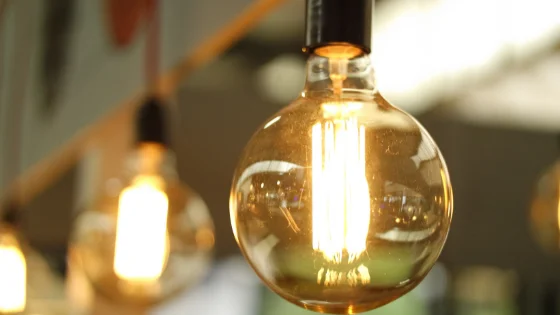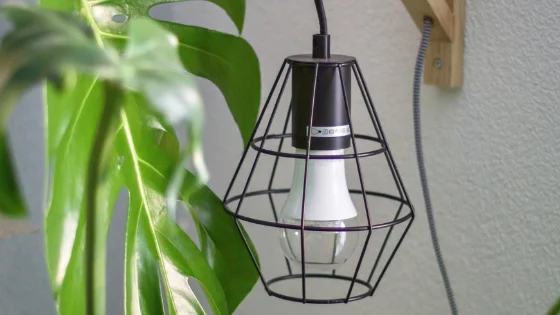You’re probably wondering at this point: can Monstera grow in artificial light? In this article we will answer this important question.
I’ll walk you through the benefits of growing monstera in artificial light, how to take care of them, and how to make sure you’re using proper artificial light if you want your monstera plants to grow.
Read More: Does Monstera Need Direct Sunlight?
Table of Contents
Can Monstera Grow In Artificial Light?
Sunlight has the right mix of wavelengths for plants to grow and bloom, but you can also use artificial light to help your Monstera plant along.
In reality, with enough artificial light, low-light foliage plants like Monstera may thrive in windowless workplaces.
To Flourish, Plants Require The Following:
- Blue wavelength light is used to promote leaf growth.
- Flowering and fruiting are aided by red wavelength light.
- Green wavelengths are of little benefit to plants and are reflected back, which is why leaves seem green.
Read More: Can Monstera Live In Low Light?
Artificial Lighting Types

Hanging tube fixtures are essential for serious seed-starting and indoor gardening, and they should be positioned directly above your plants.
Grow light kits with fixtures and reflectors are available in stores, but for typical houseplants, any lamp or light fixture will do, provided the bulbs are chosen wisely and the lamps are placed in areas where the plants would benefit the most.
Artificial Lighting:
Fluorescent lights
Houseplants benefit greatly from the low cost and simplicity of fluorescent lighting. They are available in tubes or compact fluorescent lamps (CFLs), which screw into standard lamp sockets and are cool enough to be placed near to plant leaves.
When shopping for fluorescent lighting, keep in mind that generic bulbs and tubes have a larger concentration of blue wavelengths; instead, choose for “full spectrum” bulbs or a combination of “cool” and “warm” bulbs.
If you’re unsure, go for “cool white” lighting, which encompasses the whole range of wavelengths. Fluorescent lights should be placed around a foot apart from plant leaves for best results.
Read More: How much light does a monstera need?
Incandescent lights
There is a lot of heat generated by incandescent lights, therefore they should be positioned away from plant leaves.
Due to the fact that incandescent bulbs emit more red wavelengths than fluorescent bulbs, they may be used to supplement fluorescent light and balance out the spectrum, which is particularly useful if you’re attempting to get plants to blossom.
Mixing incandescent and fluorescent bulbs may be done by utilizing a one-third incandescent to two-thirds fluorescent ratio.
LED lights
Aside from producing little heat, LED lights are also an energy-efficient form of artificial lighting. If you’re using LED lights, be sure they generate the right amount of blue and red light for your plants.
You may wish to opt for horticultural LED grow-lights rather than purchasing general-purpose bulbs since they only generate the wavelengths that plants require.
Halogen lights
The use of halogen lights may also offer full-spectrum lighting, but they generate a lot of heat and are less energy-efficient compared to fluorescent lights.
Horticultural grow lights
They are commonly packed in fluorescent fixture tubes. All the wavelengths required for flowering plants may be found in these bulbs.
Some growers find them handy for beginning seeds or propagating hybrids, while others prefer to use ordinary full-spectrum fluorescent bulbs.
Read More: Can Monstera Grow In Shade?
Suggestions for Proper Lighting
The “Spot-Gro” bulbs, which are simply labelled “plant” bulbs, should be avoided. In reality, they’re merely colored incandescent lights meant to help your plants seem nicer by making them appear greener.
Lighting For A Space With Little Natural Light
- A standing light with three bulbs, preferably one with movable or gooseneck fittings, is the best option to consider.
- In order to stay within the safe wattage rating of the fixture, use one incandescent bulb and two small fluorescent bulbs with the greatest wattages you can find.
- Lights should be directed towards your plant stand. If each fixture is independently moveable, place the fluorescent lights closer together than the incandescent bulbs to minimize heat damage.
- Make sure your plants get enough light by placing a mirror or reflecting surface beneath them.
- Set a timer for 16 hours every day.
When purchasing a grow light, there are many factors to consider

When selecting grow lights for your Monstera plant, it’s vital to remember that there are a number of aspects to consider, including the following:
How many Monstera plants do you own?
How many Monstera plants are you attempting to grow beneath the light?
The size of grow lights may range from a single bulb to those massive, meters-long fluorescent arrays hanging from the ceilings.
Perhaps a modest incandescent grow light is all you need for a little Monstera cutting if you’re simply using an ordinary desk lamp.
For bigger collections of Monstera, you may want to explore using High-Intensity Discharge (HID) grow lights instead.
How long do you really need to keep the grow light on?
You may use your grow light for only three to four hours a day if you have bright sunlight for a short moment.
This indicates that at least 10 hours of light must be provided to the plant in order for it to thrive.
If you leave your incandescent grow lights on for too long, they may soon overheat. LED lights are the ideal option in this situation since they remain cool even after long periods of usage.
Are you busy?
Consider the following scenario: you’ve purchased the most costly grow light for your Monstera plant, but you work outside most of the day. This indicates that your Monstera isn’t receiving enough light.
Your grow lights may benefit from a timer in this situation. It will allow you to arrange when your Monstera plant requires light and when it does not. Moreover, timers are now included as standard features with the majority of LED grow lights.
What is your spending limit?
You can get your Monstera plant out on the right foot with an LED grow light that costs only $10.
The more costly LED grow lights, which normally run from $200 to $500, are recommended if you’re looking for extra capabilities (such as adjustable spectrum, dimmable light, and smartphone connectivity).
Use Your New Grow Light Wisely!
How Far Above Your Monstera Should Your Grow Lights Be?
The efficiency of your grow light depends on the distance between it and your monstera plant.
You should keep your plant’s distance from grow lights at a maximum of 12 inches (30 cm). The intensity of the light drops exponentially as the distance between the plant and the grow light rises.
As a rule of thumb, you should keep incandescent bulbs at least 24 inches (60 centimeters) away from plants because of their greater heat signature.
How Long Should You Leave the Grow Light On Every Day?
Despite the fact that most grow lights can be used 24 hours a day, I suggest shutting them off and allowing your Monstera to experience darkness for at least 8 hours per day to get the best results.
plants go through a process called respiration in the dark. Plant cells use sugars made during photosynthesis and oxygen molecules to make energy so they can grow.
Conclusion
Can Monstera Grow In Artificial Light?
Every day, Monstera needs at least 10 to 12 hours of bright, indirect light. Grow lights may be used during the winter months or when the room is too dark to provide your Monstera plant with appropriate light.
Photo by Sven Brandsma on Unsplash



